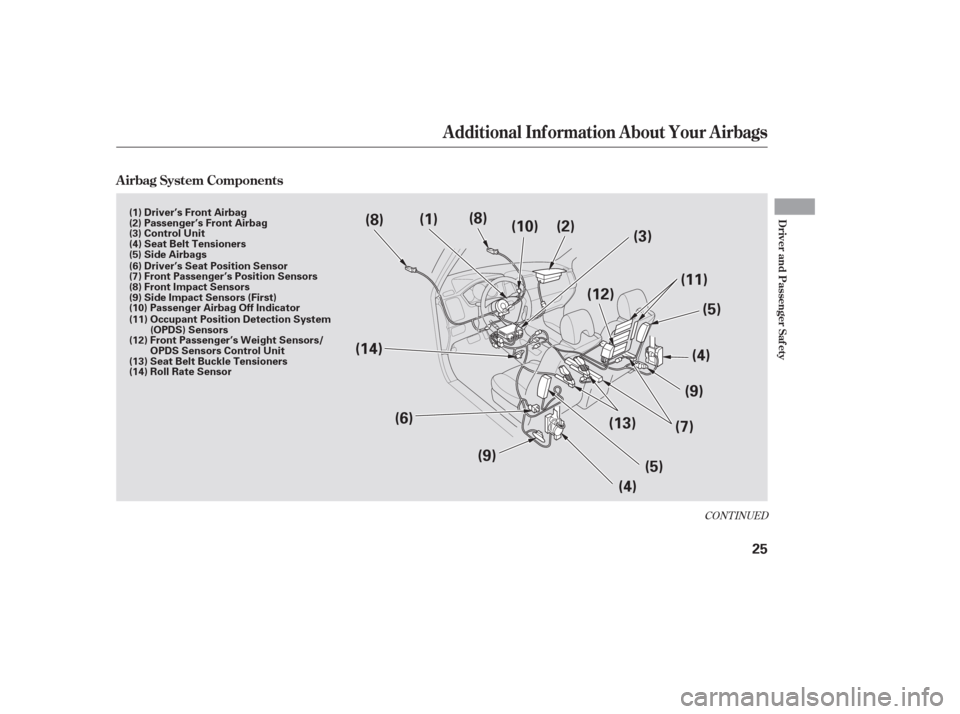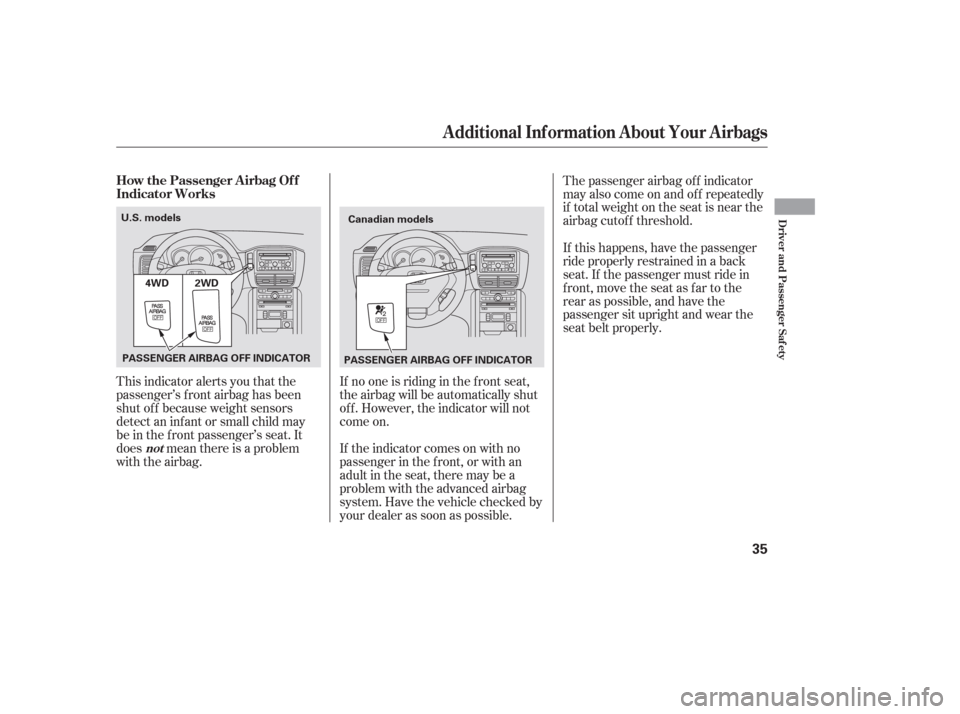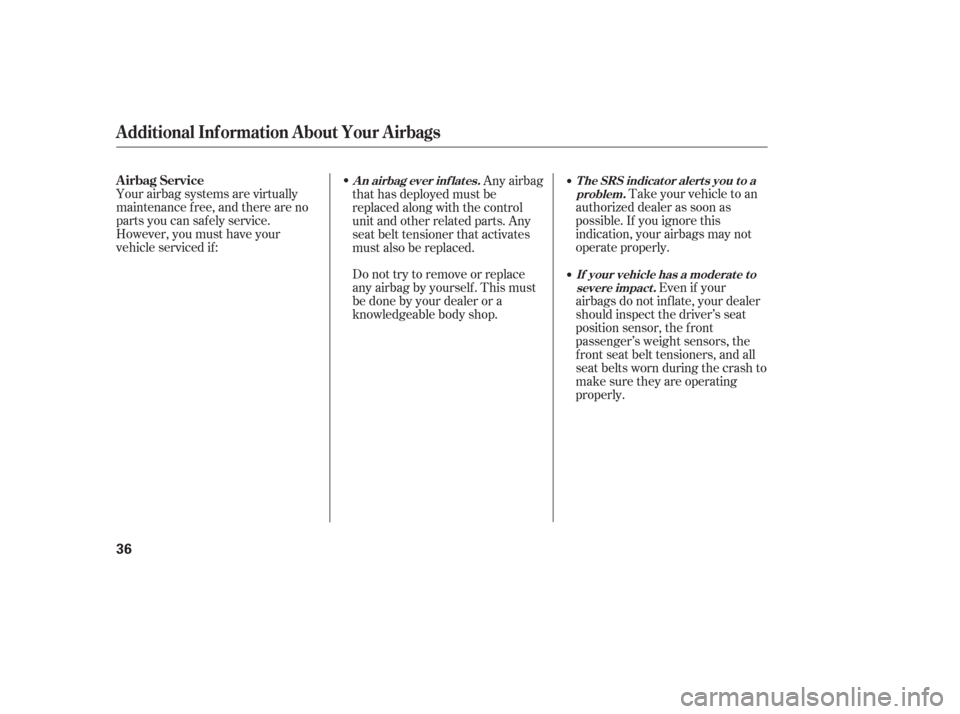weight HONDA PILOT 2006 1.G Owners Manual
[x] Cancel search | Manufacturer: HONDA, Model Year: 2006, Model line: PILOT, Model: HONDA PILOT 2006 1.GPages: 316, PDF Size: 3.95 MB
Page 27 of 316

CONT INUED
Additional Inf ormation About Your Airbags
A irbag System Components
Driver and Passenger Saf ety
25
(1)(2)
(3)
(4) (5)
(6)
(8)
(10)
(8)
(7)(9)
(9) (11)
(5)
(4)
(14)
(13)
(12)(1) Driver’s Front Airbag
(2) Passenger’s Front Airbag
(3) Control Unit
(4) Seat Belt Tensioners
(5) Side Airbags
(11) Occupant Position Detection System (OPDS) Sensors
(12) Front Passenger’s Weight Sensors/ OPDS Sensors Control Unit
(13) Seat Belt Buckle Tensioners
(14) Roll Rate Sensor
(6) Driver’s Seat Position Sensor
(7) Front Passenger’s Position Sensors
(8) Front Impact Sensors
(9) Side Impact Sensors (First)
(10) Passenger Airbag Off Indicator
Page 29 of 316

Automatic front seat belt
tensioners (see page ).
Sensors that can detect a
moderate to severe front impact or
side impact.
Sensors that can detect whether a
child is in the passenger’s side
airbag path and automatically turn
the airbag of f (see page ).
A driver’s seat position sensor that
monitors the distance of the seat
from the front airbag. If the seat is
too f ar f orward, the airbag will
inflate with less force (see page). Weight sensors that monitor the
weight on the f ront passenger’s
seat. If the weight of an inf ant or
small child is detected, the
passenger’s f ront airbag will be
turned of f (see page ).
A sophisticated electronic system
that continually monitors and
records inf ormation about the
sensors, the control unit, the
airbag activators, the seat belt
tensioners, and driver and f ront
passenger seat belt use when the
ignition switch is in the ON (II)
position.
An indicator on the instrument
panel that alerts you to a possible
problem with your airbags,
sensors, or seat belt tensioners
(see page ).
An indicator on the instrument
panel that alerts you that the
passenger’s side airbag has been
turned of f (see page ).
An indicator on the dashboard that
alerts you that the passenger’s
f ront airbag has been turned of f
(see page ).
Emergency backup power in case
your vehicle’s electrical system is
disconnected in a crash.
A roll rate sensor that monitors
the degree and rate your vehicle
may roll over and automatically
deploy the side curtain airbags and
activate the front seat belt
tensioners if needed (see page ).
23
30 31
34
3333
34
35
Additional Inf ormation About Your Airbags
Driver and Passenger Saf ety
27
Page 32 of 316

Your front airbags are also advanced
airbags. The main purpose of this
feature is to help prevent airbag-
caused injuries to short drivers and
children who ride in f ront.
For both advanced airbags to work
properly:Occupants must sit upright and
wear their seat belts properly.
Do not spill any liquids on or
under the seats, cover the sensors,
or put any cargo or metal objects
under the f ront seats.
Back-seat passengers should not
put their f eet under the f ront seats.
Failure to f ollow these instructions
could damage the sensors or prevent
them f rom working properly. The driver’s advanced front airbag
system includes a seat position
sensor under the seat. If the seat is
too f ar f orward, the airbag will
inf late with less f orce, regardless of
the severity of the impact.
If there is a problem with the sensor,
the SRS Indicator will come on, and
the airbag will inf late in the normal
manner regardless of the driver’s
seating position.The passenger’s advanced f ront
airbag system has weight sensors
under the seat. Although Honda
does not encourage carrying an
inf ant or small child in the f ront, if
the sensors detect the weight of an
inf ant or small child, the system will
automatically turn the passenger’s
front airbag off.
Advanced Airbags
Additional Inf ormation About Your Airbags
30
DRIVER’S
SEAT
POSITION
SENSOR
PASSENGER’S
SEAT WEIGHT
SENSOR
Page 33 of 316

Moving the f ront seat f orcibly
back against cargo on the seat or
f loor behind it.
Hanging heavy items on the f ront
passenger seat, or placing heavy
items in the seat-back pocket.
When the airbag is turned of f , an
indicator in the center of the
dashboard will come on indicating
passenger airbag ‘‘OFF’’ (see page
).
Also,makesurethefloormatbehind
the f ront passenger’s seat is hooked
to the floor mat anchor (see page). If it is not, the mat may
interf ere with the proper operation
of the sensors and operation of the
seat. If you ever have a moderate to
severe side impact, sensors will
detect rapid deceleration and signal
the control unit to instantly inf late
either the driver’s or the passenger’s
side airbag.
If the weight sensors detect there is
no passenger in the f ront seat, the
airbag will be off. However, the
passenger airbag of f indicator will
not come on.
To ensure that the passenger’s
advanced front airbag system will
work properly,
This includes:
A rear passenger pushing or
pulling on the back of the
passenger’s seat.
35
254
CONT INUED
How Your Side A irbags Work
Additional Inf ormation About Your Airbags
do not do anyt hing
t hat would increase or decrease t he weight on the f ront passenger’s seat.
Driver and Passenger Saf ety
31
Page 37 of 316

This indicator alerts you that the
passenger’s f ront airbag has been
shut of f because weight sensors
detect an inf ant or small child may
be in the f ront passenger’s seat. It
does mean there is a problem
with the airbag.The passenger airbag of f indicator
may also come on and of f repeatedly
if total weight on the seat is near the
airbag cutoff threshold.
If nooneisridinginthefrontseat,
the airbag will be automatically shut
of f . However, the indicator will not
come on.
If the indicator comes on with no
passenger in the f ront, or with an
adult in the seat, there may be a
problem with the advanced airbag
system. Have the vehicle checked by
your dealer as soon as possible. If this happens, have the passenger
ride properly restrained in a back
seat. If the passenger must ride in
front, move the seat as far to the
rear as possible, and have the
passenger sit upright and wear the
seat belt properly.
Additional Inf ormation About Your Airbags
How the Passenger Airbag Of f
Indicator Works
not
Driver and Passenger Saf ety
35
PASSENGER AIRBAG OFF INDICATOR
U.S. models
Canadian models
2WD
4WD
PASSENGER AIRBAG OFF INDICATOR
Page 38 of 316

Take your vehicle to an
authorized dealer as soon as
possible. If you ignore this
indication, your airbags may not
operate properly.
Your airbag systems are virtually
maintenance f ree, and there are no
parts you can saf ely service.
However, you must have your
vehicle serviced if:
Do not try to remove or replace
anyairbagbyyourself.Thismust
be done by your dealer or a
knowledgeable body shop.Any airbag
that has deployed must be
replaced along with the control
unit and other related parts. Any
seat belt tensioner that activates
must also be replaced.
Even if your
airbags do not inflate, your dealer
should inspect the driver’s seat
position sensor, the f ront
passenger’s weight sensors, the
f ront seat belt tensioners, and all
seat belts worn during the crash to
make sure they are operating
properly.
Additional Inf ormation About Your Airbags
T he SRS indicat or alert s you t o a
problem.
An airbag ever inf lates.
If your vehicle has a moderat e t osevere impact .Airbag Service
36
Page 39 of 316

Together, airbags and
seat belts provide the best
protection.
Tampering could cause
the airbags to deploy, possibly
causing very serious injury. Improperly replacing
or covering f ront seat-back covers
can prevent your side airbags f rom
inf lating during a side impact.
This could make the
driver’s seat position sensor or the
f ront passenger’s weight sensors
inef f ective. If it is necessary to
remove or modif y a f ront seat to
accommodate a person with
disabilities, f irst contact Honda
Automobile Customer Service at
(800) 999-1009. If water or another liquid
soaks into a seat-back, it can
prevent the side airbag cutof f
system f rom working properly.
Additional Inf ormation About Your Airbags
Additional Saf ety Precautions
Donotattempttodeactivateyour
airbags.
Do not tamper with airbagcomponent s or wiring f or anyreason. Do not cover or replace f ront seat -
back covers wit hout consult ingyour dealer.
Do not remove or modif y a f ront seat without consulting yourdealer. Do not expose the f ront seat-backs
to liquid.
Driver and Passenger Saf ety
37
Page 45 of 316

CONT INUED
An inf ant must be properly
restrained in a rear-f acing, reclining
child seat until the child reaches the
seat maker’s weight or height limit
for the seat and the child is at least
one year old.
Only a rear-f acing child seat provides
proper support f or a baby’s head,
neck, and back.Two types of seats may be used: a
seat designed exclusively f or inf ants,
or a convertible seat used in the rear-
f acing, reclining mode.
If placed
f acing f orward, an inf ant could be
very seriously injured during a
f rontal collision. A rear-f acing child seat can be placed
in any seating position in the back
seat, but not in the f ront.
If the passenger’s front airbag
inflates, it can hit the back of the
child seat with enough f orce to kill or
seriously injure an inf ant.
It could also interf ere with proper
operation of the passenger’s
advanced front airbag system. When properly installed, a rear-
f acing child seat may prevent the
driver or a f ront passenger f rom
moving their seat as far back as
recommended, or f rom locking their
seat-back in the desired position.
Protecting Inf ants and Small Children
Protecting Inf ants
Child Seat T ypeDo not put a rear-f acing child seat in
a f orward-f acing position. Never put a
rear-f acing child seat in t he f ront seat .
Rear-f acing Child Seat Placement
Driver and Passenger Saf ety
43
Page 46 of 316

Of the different seats available, we
recommend those that have a f ive-
point harness system as shown.We strongly recommend placing a
forward-facing child seat in a back
seat, not the front.
In any of these situations, we
strongly recommend that you install
the child seat directly behind the
f ront passenger’s seat, move the seat
as far forward as needed, and leave it
unoccupied. Or, you may wish to get
a smaller rear-f acing child seat.
A child who is at least one year old,
and who fits within the child seat
maker’s weight and height limits,
should be restrained in a f orward-
f acing, upright child seat.Even with advanced front airbags
that automatically turn the
passenger’s front airbag off (see
page ), a back seat is the saf est
place f or a small child.If the vehicle seat is too
f ar f orward, or the child’s head is
thrown f orward during a collision, an
inf lating airbag can strike the child
with enough force to cause very
serious or fatal injuries.
35
Protecting Inf ants and Small Children
Protecting Small Children
Child Seat T ype Child Seat Placement
Placing a f orward-f acing child seat int he f ront seat of a vehicle equippedwith a passenger’s airbag can behazardous.
44
Placing a rear-facing child seat
in the front seat can result in
serious injury or death during a
collision.
Always place a rear-facing child
seat in the back seat, not the
front.
Page 52 of 316

Af ter conf irming that the belt is
locked, grab the shoulder part of
the belt near the buckle, and pull
up to remove any slack from the
lap part of the belt. Remember, if
the lap part of the belt is not tight,
the child seat will not be secure.To deactivate the locking
mechanism and remove a child seat,
unlatch the buckle, unroute the seat
belt, and let the belt f ully retract.
Push and pull the child seat
f orward and f rom side-to-side to
verify that it is secure enough to
stay upright during normal driving
maneuvers. If the child seat is not
secure, unlatch the belt, allow it to
retract f ully, then repeat these
steps.
To remove slack, it may help to
putweightonthechildseat,or
push on the back of the seat while
pulling up on the belt.
4.
5.
Installing a Child Seat
50